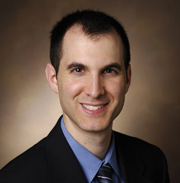by Kelsey Herbers
An Addiction Consultation Service, specialized training for physicians and changes in the language used in addiction cases are the first of many in a series of new clinical approaches being offered around addiction care as Vanderbilt University Medical Center — and the rest of the country — see an increased demand for such services.
According to David Marcovitz, MD, assistant professor of Psychiatry and medical director of the Vanderbilt University Adult Hospital Addiction Consultation Service, the Medical Center has seen a 55 percent increase this year in hospital admissions that involved opioid addiction-related diagnoses.
“We know that at the national level, more than 90 percent of patients with substance use disorders don’t seek treatment for their addictions,” Marcovitz said. “But, they consider moments when they’re in the hospital to be wake-up calls, and those are what we call reachable moments for treatment.”

The Addiction Consultation Service is a resource for physicians that offers access to a trained addiction care team five days per week. The interdisciplinary team consists of an advanced practice nurse, a psychiatrist and an addiction medicine fellow, which is a new fellowship offered at VUMC this year.
As the program expands, Marcovitz hopes the team will grow to include an internist, a social worker, a recovery coach, a patient services coordinator and a clinical pharmacist.
The team has five main priorities: initiating patients on medications for addiction treatment (MAT); providing psychiatric care for co-occurring mental illnesses; helping providers disentangle a patient’s pain issues from his or her substance use disorder; providing ongoing risk assessment; and linking patients to the outpatient addiction care continuum.
“These patients have real pain, and that creates challenges for hospital staff for two reasons: one is stigma, which can lead to the patient’s pain being undertreated, and the second is that even if doctors understand these patients have tolerance to opioids and need better pain treatment, they don’t often know how to approach it. The consult team plays a role in helping them understand how to both treat patients with acute pain and set limits in terms of prescription opioids for chronic pain,” said Marcovitz.
Since its official launch in July, the consult service has assisted with 340 inpatient visits. Many of the patients admitted face serious skin and soft tissue infections such as cellulitis, endocarditis and spinal epidural abscesses due to injections with nonsterile needles. Several of these conditions can be life-threatening or lead to paralysis.
The collaborative effort of the consult service provides a more “whole person” approach to addiction care, treating not only the current infections but the mental illnesses at the root of the problem. The program bridges the gap between a medical/surgical-only approach, which may fail to address underlying mental illnesses, and a psychiatry-only approach, which may fail to fully integrate into the patient’s overall medical care. Patients who receive integrated care have proven more likely to be abstinent from alcohol and drugs in the months immediately following intervention.
“This service fills a major void in addressing the opioid epidemic, which has become especially problematic in the state of Tennessee,” said Dan Lonergan, MD, assistant professor of Clinical Anesthesiology in the Division of Pain Medicine and medical director of the Comprehensive Pain Consult Service. “It is critical that we care for these patients with the most current medical evidence and without the stigma that is often associated with these situations. The addiction consult service will help us stay up to date and deliver the best evidence-based care in an area where there is significant need.”
“The issue is that the care continuum is fragmented for these patients,” said Marcovitz, mentioning that many patients are given the phone numbers of outpatient addiction services upon discharge, which they may or may not use to follow up on their care.
“We know that when patients are not systematically started on medications to treat opioid use disorder, they don’t stay engaged because the habit of using opioids is too powerful and their brains are already disrupted in terms of their executive function and their concept of what’s rewarding. If you make it challenging for them to follow up on their care, they’re not going to.”
VUMC also recently began providing on-campus training for multi-specialty providers to be able to prescribe buprenorphine, a drug used to treat opioid dependence. Administering the drug requires a special federal waiver and eight hours of training. The first two trainings at Vanderbilt took place in late October with nearly 40 providers completing the course. Another training is scheduled for late November, and efforts are under way to research the impact of the intervention.
Additionally, Marcovitz and his team are working to break down the stigma surrounding patients with addiction by changing the language used to denote the condition.
For example, instead of describing patients as “addicts” or “substance abusers,” which implies willful misconduct, Marcovitz teaches colleagues to use the phrase “person with a substance use disorder,” which removes unhelpful labeling that equates the patient with his or her illness.
With more initiatives planned for the coming months, the Department of Psychiatry and Behavioral Sciences’ underlying goal is to build a context around addiction care to keep patients engaged in treatment so they don’t return to the hospital with worse infections and more severe substance use disorders.












